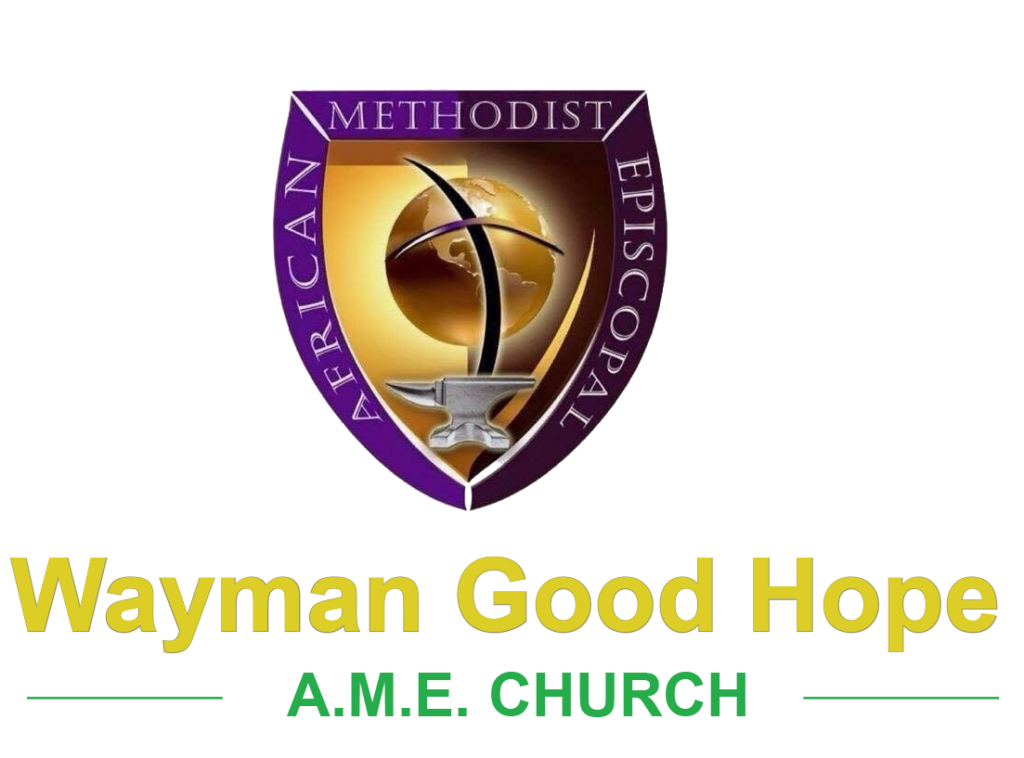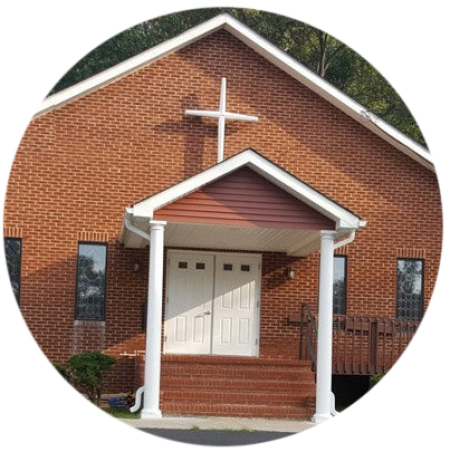ABOUT WAYMAN
A CHURCH WITH A VISION OF GOOD HOPE

History of Wayman Good Hope A.M.E. Church
100 Hoyle Lane, Severna Park, Maryland 21146
Wayman Good Hope A.M.E. Church originated as Baldwin Good Hope A. M. E. Church. According to Anne Arundel County Records, the place of divine worship variously known as “Baldwin Good Hope A.M.E. Church”, “Wayman Good Hope African Methodist Episcopal Church of Anne Arundel County, Maryland”, and the “Wayman Good Hope African Methodist Episcopal Church”, was duly incorporated as “Baldwin’s Good Hope Chapel”, by Articles of Incorporation dated January 3, 1885.
The church was originally built on three acres of land at Carpenter’s Hill, Round Bay, Maryland. The members at that time included families from Round Bay and Arnold. After the church building was destroyed by fire on two separate occasions, some of the members living in Arnold and Mt. Calvary decided to withdraw. They purchased land in Arnold, affiliated with the Methodist Conference and built a church close to their homes. The remaining members continued to worship in the homes of members until a new church building was acquired. The original church property is still a burial site for members, and is named Carpenter’s Cemetery.
In 1907, these remaining members of Baldwin purchased additional land in Jones, Maryland from Mrs. Marie Dorsey. Because the land was located a long distance from the main road, the members negotiated an equal land trade with Brother Wilson Dorsey. The members engaged a carpenter from Eastport, Maryland to construct a new church and benches and in July 1908, the cornerstone was laid in Jones, on Old County Road. Brother Wilson Dorsey was made a Trustee, giving the church a total of seven trustees. In 1864, Bishop Alexander Washington Wayman was consecrated as the seventh Bishop of the A.M.E. Church and served for thirty-one years. Because Bishop Wayman, a former pastor in the Baltimore-Washington Conference, was serving in the area at the time of the rebuilding of this worship facility, the members and trustees decided to change the name of the Church to “Wayman Good Hope African Methodist Episcopal Church.”The elected trustees were Brothers William Smith, President; John Kiah, Church Secretary; Jim Kelly, Treasurer; Charles White, George Stewart, Andrew Norris and Wilson Dorsey. The appointed Stewards were: Henson Brown, Sr., John Kelly and William Mason Kiah. The Stewardesses were: Harriet Mason, Luck Kelly, Elizabeth White, Beck Walker, and Ellen Allen, who also served as the Treasurer.
The community and church continued to grow. However, because of its size, Wayman Good Hope was placed on the Circuit with Mt. Olive A.M.E. Church in Parole, with both churches on this Circuit were served by one pastor. Assigned to pastor these two congregations during these early years were Rev. Powell, Rev. Leake, Rev. Beckett, Rev. Banks, Rev. E. O. Plummer, Rev. E.N. Thomas, and Rev. J. W. Armstrong. Rev. Plummer, an employee at Fort Meade during World War I, was instrumental in helping to get electricity installed at Wayman Good Hope.
Given the Church’s increase in membership, Rev. J. Frank Howard, a retired Army Chaplain who had built a home in Jones, was appointed as the new pastor. After Rev. Howard, the following pastors served: Rev. E. N. Thomas, for a second term; Rev. I. S. Harmon, Rev. T. J. Jackson, Rev. T. C. Freeman, Rev. W. A. Stewart, Rev. Rufus L. Bond, Rev. T. B. McQueen, Rev. T. N. Hawkins, Rev. D. E. Makell, and Rev. Savarette Morse.
In 1947, a parsonage was constructed by J. Raymond Tolson of Arnold, at a total cost of $1,865.00. Running water was added to the Church and an elementary school and high school were constructed on the Church property. Church membership continued to increase as descendants from the White, Brown, and Jackson families, and families from all over the area joined the church. In time, the wooden church started to need repairs and members realized that a new church building was needed.
The building project began under the leadership of Rev. Samuel A. Beard who was appointed pastor and served the church faithfully. In 1967, Rev. Young was appointed pastor. Under his leadership—and with his vision, encouragement, and the implementation of a building fund—the building of a new church facility was begun. Although Rev. J. L. Young served for 11 years, he did not complete the building before his death. Thus, the completion of the new church building was accomplished by the next pastor, Rev. Sherman Green; in 1979 when the first cornerstone was laid the new church was dedicated in 1984 by Bishop John Hurst Adams. Rev. Green was succeeded by Rev. J. G. Barnes, who served for three years.Following Rev. Barnes, Rev. Ullysses Brooks, Jr. was appointed as pastor and served for five years. Rev. Brooks made numerous improvements to the church building. He added the stained glass windows, made improvements to the kitchen area, and converted the storage room on the first floor to a restroom. Rev. Mack M. Bell who succeeded Rev. Brooks led the Church in constructing a new parsonage on the Church property. The new facility was dedicated by Bishop Frederick Calhoun James. Rev. Bell served faithfully for eight years.
Rev. Dana A. Swann was appointed as pastor in 1997 and served with continued visions for future growth for the church and the church family. His dedication, continued emphasis on teaching the word, and encouragement to all members of the church was beneficial to the spiritual growth and empowerment of the church.
In April 2005, Rev. Constance C. Wheeler was appointed to the pastorate of Wayman Good Hope. She was the first woman to serve as pastor of Wayman, and encouraged the involvement of “families working together to bring forth a new vision of God” at Wayman Good Hope. Her dynamic personality and spiritual leadership allowed the members to express their individuality and God-given talents.
In April 2011, Rev. Dr. Lois A. Poag-Ray was appointed pastor. Pastor Poag-Ray has challenged the Congregation to embrace the rich spiritual history of African Methodism while adapting and implementing strategies and programs to meet the needs of the ever-changing community in which we serve. Under her leadership, new ministries have been developed, Church organizations have been revitalized, and many improvements have been made to the Church facilities. The burning of the mortgage for the parsonage, now renamed “Wayman House,” has been realized during her tenure.
Wayman Good Hope A. M. E. Church continues to grow, not only in number, but also in grace and in the knowledge of our Lord and Savior Jesus Christ. All who have been a part of this Church family praise God for the many years of faithful worship and service, and for the work that has gone forth from these hallowed grounds. May this community of faith continue to be a beacon of “good hope” for all who come seeking a place of worship and a church home. To God be the Glory!
A GENERAL STATEMENT of MISSION, PURPOSE, and VISION

The Overall Mission of Wayman Good Hope African Methodist Episcopal Church is first and foremost in compliance with the general Mission of the African Methodist Episcopal Church as noted in The Book of Discipline of the African Methodist Episcopal Church which states, “The “Mission of the A.M.E. Church is to minister to the social, spiritual, and physical development of all people.” (2013, p.13) Furthermore, our vision, purposes, and objectives comply with the statements as noted in this same section. Additionally, Wayman Good Hope A.M.E. Church has adopted the following statements as our expressed operational “Mission, Purpose, and Vision:”
